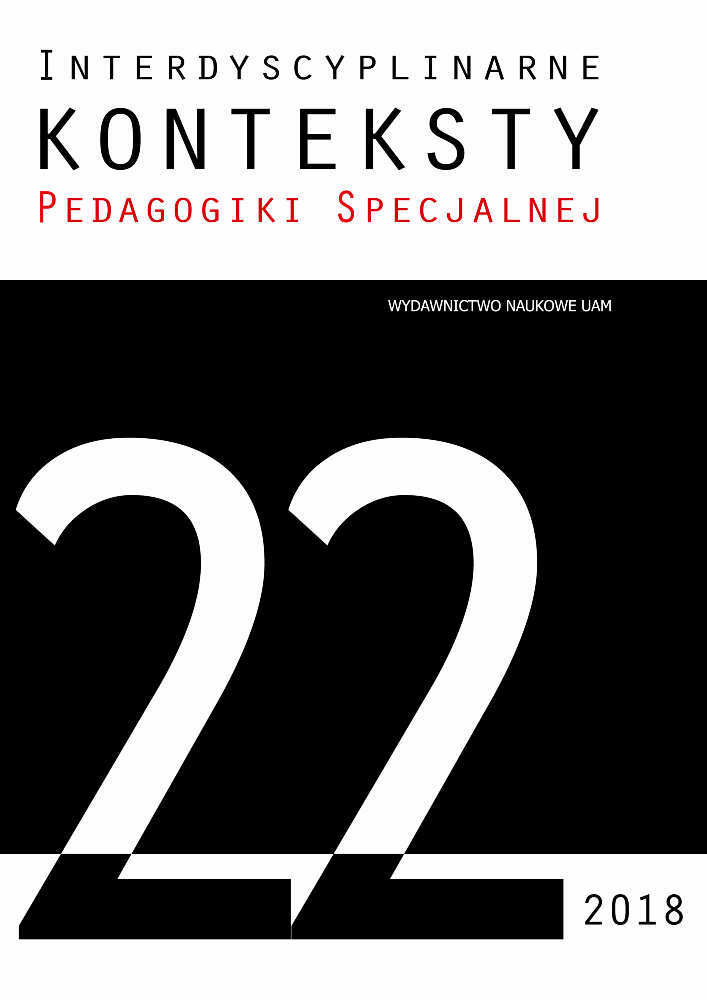Abstrakt
Paweł Cylulko, Oddziaływania tyflomuzykoterapeutyczne wspierające rozwój ruchowy dziecka z niepełnosprawnością wzroku [Typhlo music therapy interventions that facilitate motor development of visually impaired children]. Interdyscyplinarne Konteksty Pedagogiki Specjalnej, nr 22, Poznań 2018. Pp. 153-30. Adam Mickiewicz University Press. ISSN 2300-391X. DOI: https://doi.org/10.14746/ikps.2018.22.09
The article discusses the possibilities of using music therapy to facilitate motor development of children with visual impairments. Cognitive functioning of children without vision implies certain psychophysiological, emotional and social problems, including substantial delay in motor development in comparison to non-impaired peers. Thanks to the integration of music with various forms of movement and the sonic and musical interaction between a music therapist and a child, it is possible to reduce the child’s psychomotor delay, and improve their orientation and locomotion in small and large spaces. The author, musician, teacher and music therapist, shares his observations and experiences gained during almost thirty years of work
with children at the Maria Grzegorzewska Lower Silesian Special Educational Centre No. 13 for the Blind and the Visually Impaired in Wrocław.
Bibliografia
Antović M., Bennett A., Turner M., Running in circles or moving along lines: Conceptualization of musical elements in sighted and blind children, „Musicae scientiae” 2013, nr 17(2).
Bertolami M.D., Martino L.A., Music Therapy in a Private School for Visually Impaired and Multiply Handicapped Children, „In Voices: A World Forum for Music Therapy” 2002, t. 2, nr 1, https://voices.no/index.php/voices/article/view/69/59 [dostęp: 24.06.2018].
Brambring M., Divergent development of gross motor skills in children who are blind or sighted, „Journal of Visual Impairment & Blindness” 2006, nr 100(10).
Darrow A.A., Novak J., The effect of vision and hearing loss on listeners’ perception of referential meaning in music, „Journal of Music Therapy” 2007, nr 44.
Decker-Voigt H.H., Musiktherapeutische Hilfen für die Begleitung von Blinder und Schbenhinderten, „Musiktherapeutische Umschau” 1994, t. 15, nr 2.
Dziedzic-Szeszuła E., Wprowadzenie, [w:] W. Wróblewski Taniec Towarzyski w rehabilitacji osób niewidomych, AWF, Poznań 2005.
Eitan Z., Ornoy E., Granot R.Y., Listening in the dark: Congenital and early blindness and cross-domain mappings in music, „Psychomusicology” 2012, nr 22(1).
Emery R., Blind role models in rehabilitation, „Journal of Visual Impairment and Blindness” 1986, nr 80(9).
Flowers P.J., Wang C.H., Matching verbal description to music excerpt: The use of language by blind and sighted children, „Journal of Research in Music Education” 2002, nr 50(3).
Haibach P.S., Wagner M.O., Lieberman L.J., Determinants of gross motor skill performance in children with visual impairments, „Research in developmental disabilities” 2014, nr 35(10).
Kędzierska J., Planowanie pracy rewalidacyjnej z dziećmi niewidomymi i słabowidzącymi w szkołach ogólnodostępnych, [w:] Dajmy szansę niewidomym i słabowidzącym. Poradnik metodyczny dla nauczycieli, red. T. Żółkowska, „Pedagogium” Wydawnictwo OR TWP w Szczecinie, Szczecin 2010.
Kern P., Wolery M., Participation of a preschooler with visual impairments on the playground: Effects of musical adaptations and staff development, „Journal of Music therapy” 2001, nr 38(2).
Kuczyńska-Kwapisz J., Spostrzeżenia dotyczące prowadzenia zajęć z młodzieżą niewidomą w kole tanecznym, „Szkoła Specjalna” 1979, nr 4.
Lam R. C., Wang C., Integrating Blind and Sighted through Music, „Music Educators Journal” 1982, nr 68(8).
Levtzion‐Korach O., Tennenbaum A., Schnitzer R., Ornoy A., Early motor development of blind children, „Journal of paediatrics and child health” 2000, nr 36(3).
Malloch S.N., Mothers and infants and communicative musicality, „Musicae scientiae” 1993, nr 1_suppl.
Mazurkiewicz A., Zainteresowania muzyczno-taneczne niewidomych, „Kultura Fizyczna” 1968, R. XXI, nr 3.
Metell M., „A great moment… because of the music”: An exploratory study on music therapy and early interaction with children with visual impairment and their sighted caregivers, „British Journal of Visual Impairment” 2015, nr 33(2).
Miedziak A.I., Perski T., Andrews P.P., Donoso L.A., Stargardt’s macular dystrophy – a patient’s perspective, „Optometry” 2000, nr 71(3).
Murphy F.M, O’Driscoll M., Observations on the Motor Development of Visually Impaired Children Interpretations from Video Recordings, „Physiotherapy” 1989, nr 75(9).
Okupińska A., Zagadnienia rehabilitacji i edukacji osób głuchoniewidomych, [w:] Dajmy szansę niewidomym i słabowidzącym. Poradnik metodyczny dla nauczycieli, red. T. Żółkowska, „Pedagogium” Wydawnictwo OR TWP w Szczecinie, Szczecin 2010.
Olszewska W., Ewolucja w muzykoterapii ze szczególnym uwzględnieniem metody Karla Orffa, „Postępy Rehabilitacji” 1992, nr 3, s. 61-68.
Palak Z., Uczniowie niewidomi słabowidzący w szkołach ogólnodostępnych, Wydawnictwo UMCS, Lublin 2000.
Pavlicevic M., Dynamie interplay in clinical improvisation, „The Journal of British Music Therapy” 1990, t. 4, nr 2.
Pfammatter X., Music as a Leisure-Time Occupation for the Blind, „Review of the European Blind” 1988, nr 2(60).
Pielecki A., Skrzetuska E., Nauczanie niedowidzących w klasach 4-8, WSiP, Warszawa 1991.
Preisler G.M., A descriptive study of blind children in nurseries with sighted children, „Child:care, health and development” 1993, nr 19(5).
Sapp W., Somebody’s jumping on the floor: incorporating music into orientation and mobility for preschoolers with visual impairments, „Journal of Visual Impairment & Blindness” 2011, nr 105(10).
Sobey K., Out of sight – out of mind?, Reflections on a blind young woman’s use of music therapy, „The Journal of British Music Therapy” 1999, t. 7, nr 2.
Stadnicka J., Rewalidacja dzieci niewidomych przez rytmikę, „Szkoła Specjalna” 1990, nr 2-3.
Steele A.L., Crawford C., Music Therapy for the Visually Impaired, „Education of the Visually Handicapped” 1982, nr 14(2).
Tröster H., Brambring M., Early motor development in blind infants, „Journal of applied developmental psychology” 1993, nr 14(1).
Wolf F. M., Music Therapy with the Blind, „British Journal of Music Therapy” 1978, nr 9(3).
Wróblewski W., Taniec Towarzyski w rehabilitacji osób niewidomych, AWF, Poznań 2005.
Wypart R., Praca nauczyciela wychowania fizycznego z uczniem z dysfunkcją wzroku, [w:] Dajmy szansę niewidomym i słabowidzącym. Poradnik metodyczny dla nauczycieli, red. Żółkowska Teresa, „Pedagogium” Wydawnictwo OR TWP w Szczecinie, Szczecin 2010.
Zamęcka H., Metody działania muzykoterapeuty w pracy z dziećmi z uszkodzonym wzrokiem, „Szkoła Specjalna” 1985, nr 3.
